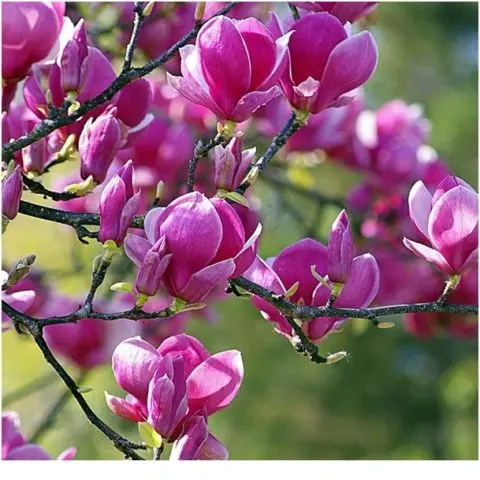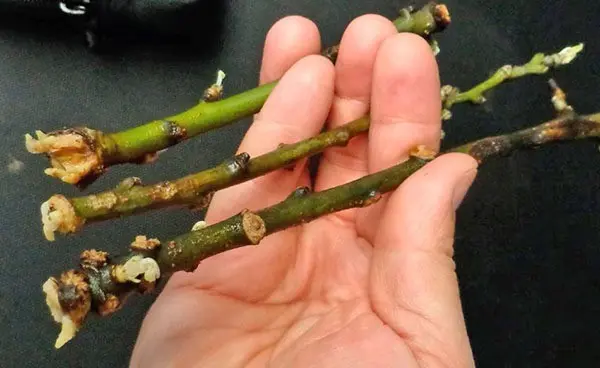Contents
Magnolia Black Tulip is an amazingly beautiful variety of culture obtained by New Zealand breeders as a result of crossing varieties of Iolanta and Vulcan. Magnolia Black Tulip is not very well known among gardeners, as evidenced by the almost complete absence of reviews about it.
Description of Magnolia Black Tulip
This is an ornamental deciduous tree or shrub up to 5–6 m high with medium-sized green oval leaves. The pyramidal crown becomes more spreading and wider with age, reaching a diameter of 3 m. The root system is superficial.
The variety is characterized by good frost resistance and is practically not susceptible to diseases.

How magnolia Black Tulip blooms
Magnolia Black Tulip blooms profusely at the very beginning of spring, even before the leaves appear, with large single flowers up to 18 cm in diameter. The goblet corolla, formed by velvety petals, gives the flower a resemblance to a tulip. One of the distinguishing features of the Black Tulip magnolia flowers is an unusual dark purple hue, which is considered one of the darkest among the varieties of magnolias with red flowers.
With a humid and not very hot summer, the Black Tulip variety may bloom again in mid-June.
Methods of reproduction
Magnolia reproduces very well vegetatively, that is, cuttings and layering. Propagation by seeds is practiced extremely rarely.
To get a daughter plant from layering, in the spring they bend down the lower shoot of the mother plant, fix it on the soil and sprinkle it with earth. After 1-2 years, the branch takes root, it is separated and transplanted.
You can start propagating Magnolia Black Tulip with cuttings in the middle of summer. To do this, young branches of the plant are cut, placed in a sand-based substrate and provided with a constantly moist, warm environment. Rooting takes from 2 to 4 months, and a year later, young shoots can be planted in open ground.

Another common way to grow magnolia is by grafting. On the trunk of another crop or a more hardy and frost-resistant magnolia variety, a cutting of the Black Tulip variety with vegetative buds is grafted. Most often, this method is used by professional gardeners, since propagation by grafting requires certain skills and adherence to technology.
To grow Black Tulip magnolia from seeds collected in the fall, they are sealed in boxes with universal soil and cleaned in a cool place until spring. Before planting young plants in open ground, seedlings are carefully looked after.
Planting and care
It is best to purchase a Black Tulip magnolia seedling from a nursery or specialized garden center. Planting material should be chosen with a closed root system, since such plants take root better.
Recommended dates
Despite the fact that magnolia farming involves both spring and autumn planting, most experienced gardeners recommend planting this plant in open ground in mid-October, after the growing season has ended. An argument against spring planting is the risk of April frosts returning, from which the magnolia can be severely affected. Magnolia in a container can be planted throughout the summer.
Site selection and preparation of soil
When choosing a site for planting magnolia of this variety, open windy areas should be avoided. Despite frost resistance, the plant can suffer from cold winter winds. It prefers well-lit areas, but direct sunlight adversely affects the pigmentation of the leaves – they fade and acquire a light yellow tint. The direct midday sun is especially harmful to young seedlings. Magnolia feels good in diffused light and in partial shade.
Magnolia Black Tulip is not too demanding on the soil: it will grow best in soils with a neutral or acidic reaction; in substrates with a high content of lime and salts, its growth noticeably deteriorates. The soil should be fertile, loose, moist, but without stagnant water. Well suited sandy, loamy and clay soils.
Preparing a site for planting a magnolia primarily involves draining the soil, since the plant needs a lot of water, and it does not tolerate stagnant moisture. If the soil is limed, it is acidified with peat.
How to plant
To plant a magnolia, you need:
- dig a landing hole with a diameter of 100 cm and a depth of 60 cm;
- prepare a nutritious soil mixture from soddy land, peat, sand and rotted compost;
- pour a layer of prepared soil mixture 20–30 cm thick on the bottom;
- place the seedling in the hole and cover with the remaining soil. The soil should not be compacted so as not to impede the access of air to the roots;
- water the plant;
- mulch the trunk circle with coniferous bark, sand or peat.
When planting several trees, the size of adult specimens is taken into account. As a rule, a distance of 4–5 m is maintained between them.
Growing rules
In order to provide Black Tulip magnolia with comfortable conditions in the gardens of the middle lane, it must be borne in mind that its homeland is areas with a warm, humid climate, so regular watering plays a paramount role. Feeding and pruning are also necessary to grow a healthy flowering tree. The achievements of modern breeding have made it possible to achieve high frost resistance of this variety, however, proper preparation for winter is an important part of caring for the Black Tulip variety.
Watering
During dry summers, Black Tulip magnolia is watered 2-3 times a week with soft water. It is good to use rain, settled or acidified with a small amount of peat water. Usually 1 plant consumes about 2 buckets of water.
Young seedlings need more moisture, they are watered once every 1 days at the rate of 7 liters of water per plant.
Mulching will help to keep moisture, get rid of weeds and improve the chemical composition of the soil.
Additional fertilizing
The first 2 years after planting, Black Tulip magnolia does not need to be fed. In the future, plantings are fertilized with ready-made mineral complexes or they prepare a nutrient solution for irrigation on their own. In 10 liters of water, dissolve 1 tbsp. l. urea and ammonium nitrate and add 1 kg of cow manure.
Magnolia is fed from the beginning of March until the end of summer. Fertilizer with nitrogenous complexes is stopped in the middle of summer, so as not to disturb the natural preparation of the plant for winter.
Trimming
Black Tulip magnolia pruning is carried out in order to improve decorativeness and general health. Formative pruning is not necessary. Immediately after flowering, it is enough to cut off the inflorescences and dried branches, and after winter, cut off the frozen shoots. Branches growing inward are also subject to removal.
Preparation for winter
One of the mandatory steps in preparing the Black Tulip magnolia for winter is the mulching of near-stem circles. It is produced after the first frost. Spruce branches, bark of coniferous trees, peat or leaves are used as mulch.
In the middle lane, only young plants (up to 5 years) are covered for the winter. The barrel is securely wrapped with two layers of burlap. Other insulating material will do. This will protect the plant not only from frost, but also from rodents. If the area with magnolia is blown by the winds, it makes sense to cover the crown of the tree with the same material.
Mature trees are able to withstand frosts down to -32 ° C, but if a harsh winter is expected, it is advisable to cover them.

The greatest danger for magnolia is return frosts, because when the temperature rises, vegetative processes begin and flower buds form, which are not able to withstand even a short-term drop in temperature to negative values.
Pests and diseases
Magnolia Black Tulip rarely gets sick, pests, primarily rodents, that infect the roots and trunk, are a great danger to it. Special repellers will help to cope with them.
The spider mite is very harmful to the plant. Settling on the underside of the leaves and multiplying rapidly, it can lead to the death of the leaves. You can get rid of it by spraying the tree with insecticides or folk remedies, for example, infusion of onion or garlic peel, tobacco dust, mustard powder. It is also useful to carry out preventive spraying of plantings, especially if hot, dry weather has set in, since it is under such conditions that pests are especially active.
When growing magnolia on soils with a high content of lime and a lack of iron, it can become ill with chlorosis, in which the leaves turn yellow and fall off for no apparent reason. Acidifying the soil and enriching it with iron chelate will help correct the situation.
Conclusion
Magnolia Black Tulip is a young variety that is gaining an increasing number of fans among gardeners. A flowering tree can become a real gem of a garden – the incredibly beautiful flowers of this variety invariably catch the eye. At the same time, agricultural technology is not very difficult – the plant does not impose special requirements for care and feels comfortable in the middle lane with minimal care.









